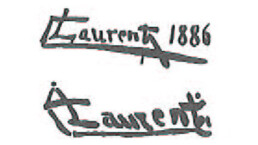
Laurenti Cesare *
LAURENTI CESARE
Mesola (Ferrara) 1854 – Venezia 1936
Studiò privatamente a Padova e dopo all’Accademia di Firenze; si recò poi a Napoli, accostandosi a F. Palizzi e a D. Morelli. Stabilitosi a Venezia riscosse un primo successo con soggetti aneddotici sul genere di quelli di P. Fragiacomo (Ciaccole, 1887, coll. privata) per poi passare a un verismo più attento (La capinera, 1894, coll. privata). Dal 1881 al 1911 partecipò con una vasta produzione alle esposizioni di Firenze (1881, A Pompei- mezza figura, Al fonte, A compieta), di Milano (1882, Novembre, Prete, Un baso a la più bela; 1884, A Venezia, Scaramuccie al confine, Lutto), di Torino (1882, Tu ne morrai – povero fior!) e di Venezia (1887, fra gli altri, Frons animi interpres, Trieste, Museo Revoltella; 1907, fra gli altri, Primo dubbio, Via aspra, entrambi a Roma, Galleria Nazionale d’Arte Moderna). Nel 1894 fu premiato a Milano per il dipinto Le parche e nel 1900 vinse la medaglia d’oro a Monaco con II peccato. Intorno alla fine del secolo si accostò al gusto simbolista (La vedova, 1896 ca.; Fioritura nuova, esposto nel 1897 alla Biennale di Venezia e a Parigi nel 1900, entrambi a Venezia, Galleria d’Arte Moderna di Ca’ Pesaro). Attivissimo anche come architetto, scultore e ceramista, si deve a lui il progetto per l’edificio della Pescheria di Rialto a Venezia e la decorazione dell’ex albergo liberty “Lo storione” a Padova.
